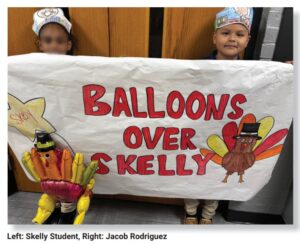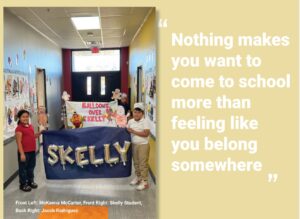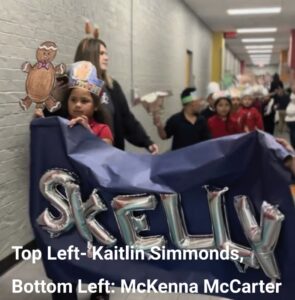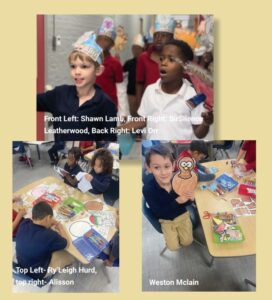Marching into Memories: How a First-Grade Parade Builds Community
More than just a parade—Balloons Over Skelly teaches creativity, collaboration, and confidence.
By Joe DuVall, OEA Communications Staff
 Public schools are full of magic, and at Skelly Elementary in Tulsa, the magic marches down the hallways.
Public schools are full of magic, and at Skelly Elementary in Tulsa, the magic marches down the hallways.
Inspired by the beloved children’s book Balloons Over Broadway, first-grade teacher Kaitlin Simmonds and the dedicated first-grade team transformed a classroom activity into a schoolwide celebration, bringing learning to life in a way their students will never forget.
The book tells the story of Tony Sarg, the inventor of the massive balloons featured in the Macy’s Thanksgiving Day Parade. It became the perfect launching point for Skelly’s first-graders to dive into creativity, imagination, and hands-on learning.
“The story is about how Tony Sarg started inventing when he was six years old, just like our students,” Simmonds explained. “We wanted them to see that their ideas can become reality.”
For years, Simmonds had incorporated the book into her classroom at that scale, but this year, everything changed when fellow first-grade teacher Shannon Stewart reached out with a question: “Have you ever read this book, Balloons over Broadway?”
Realizing her classroom project could be much more, Simmonds ignited a collaborative effort among the entire first-grade team, including Stewart, Alexia Wallace, Stephanie Worley, and Krystie Lopez. And with the enthusiastic support of the school’s principal Jennifer Heard and assistant principals Amanda Jones and Omeke Alikor, the project blossomed into a full-fledged school event. First-graders designed and created their own “balloons” out of paper, complete with arms, legs, and vibrant decorations.

The preparation for the parade was just as meaningful as the event itself. Students spent days brainstorming and sketching out their balloon ideas, discussing colors, shapes, and themes. Teachers incorporated writing assignments where students described their balloon designs and explained their choices. The activity encouraged creativity and reinforced fine motor skills as students carefully cut, glued, and pieced together their paper balloons.
“It wasn’t just about having fun,” Simmonds said. “There was real learning behind it, from writing and storytelling to art and engineering.”
The school’s staff rallied behind the project, ensuring that every student had the materials they needed to bring their visions to life. “It was amazing to see our entire first-grade team come together,” Simmonds said. “Everyone played a part in making this happen.”

When parade day finally arrived, the excitement was palpable. The hallways buzzed with anticipation as students lined up with their creations. Parade music filled the air, and students proudly marched down the halls, holding their paper balloons high. The rest of the school lined the walls, clapping and cheering in support of their younger peers.
“It was truly magical,” Simmonds recalled. “Fifth-graders asked if they could make signs to cheer on the first-graders, and the entire school was engaged. It felt like we had created something really special.”
For the first-graders, this experience was about more than just fun—it was about belonging. Simmonds and her team wanted their students to feel valued, to know that their work mattered, and to experience firsthand the joy of learning.
“Nothing makes you want to come to school more than feeling like you belong somewhere,” she said. “We want our kids to have these core memories—moments that make learning feel exciting and important.”
What started as a book study has now turned into a new tradition, one that will welcome each new class of first-graders with open arms.
“As these kids grow, they’ll become the ones cheering for the younger students, just like the older kids did for them,” Simmonds said. “It’s something special, something they can look forward to every year.”

Reflecting on the success of the event, Simmonds noted how it reinforced the sense of community at Skelly Elementary. “It’s not just about the lesson itself, but about the feeling it creates,” she said. “We want students to feel like they are part of something bigger, that they are supported, and that their creativity is valued.”
She also hopes this story can inspire other educators to think outside the box. “Sometimes it can feel risky to step away from the curriculum, but we found ways to align this project with our learning goals,” she explained. “The students wrote about their designs, used problem-solving skills to construct their balloons, and engaged in discussions about traditions, engineering, and storytelling. It was learning through play, and that’s so valuable.”
Beyond the academic benefits, Simmonds and her team see this project as a way to foster excitement about school. “We want them to wake up excited to come to school, knowing that there’s something fun and meaningful waiting for them,” she said. “When students associate school with joy and creativity, they’re more eager to learn.”
The impact of the parade will extend far beyond the first-grade hallway. Younger students who watched this year will one day be the ones holding the balloons, knowing that their moment to shine is just around the corner. Older students who once walked in the parade will return as spectators, cheering on the next wave of first-graders, continuing the cycle of encouragement and excitement.
Educators understand that learning isn’t just about textbooks and tests—it’s about the magic behind the doors, the moments that make school feel like home. And for one morning each year at Skelly Elementary, that magic will march proudly down the hallways, paper balloons held high, in a parade of joy, community, and endless possibilities.
These kinds of stories unfold in public schools every day—stories of creativity, innovation, and belonging that often go unnoticed by those who never step inside. While some attempt to paint a false narrative about what happens in our classrooms, the truth is right here: students learning, growing, and thriving in ways that cannot be measured by test scores alone.
This story was a part of the 2025 Spring edition of OEA’s Education Focus magazine.
